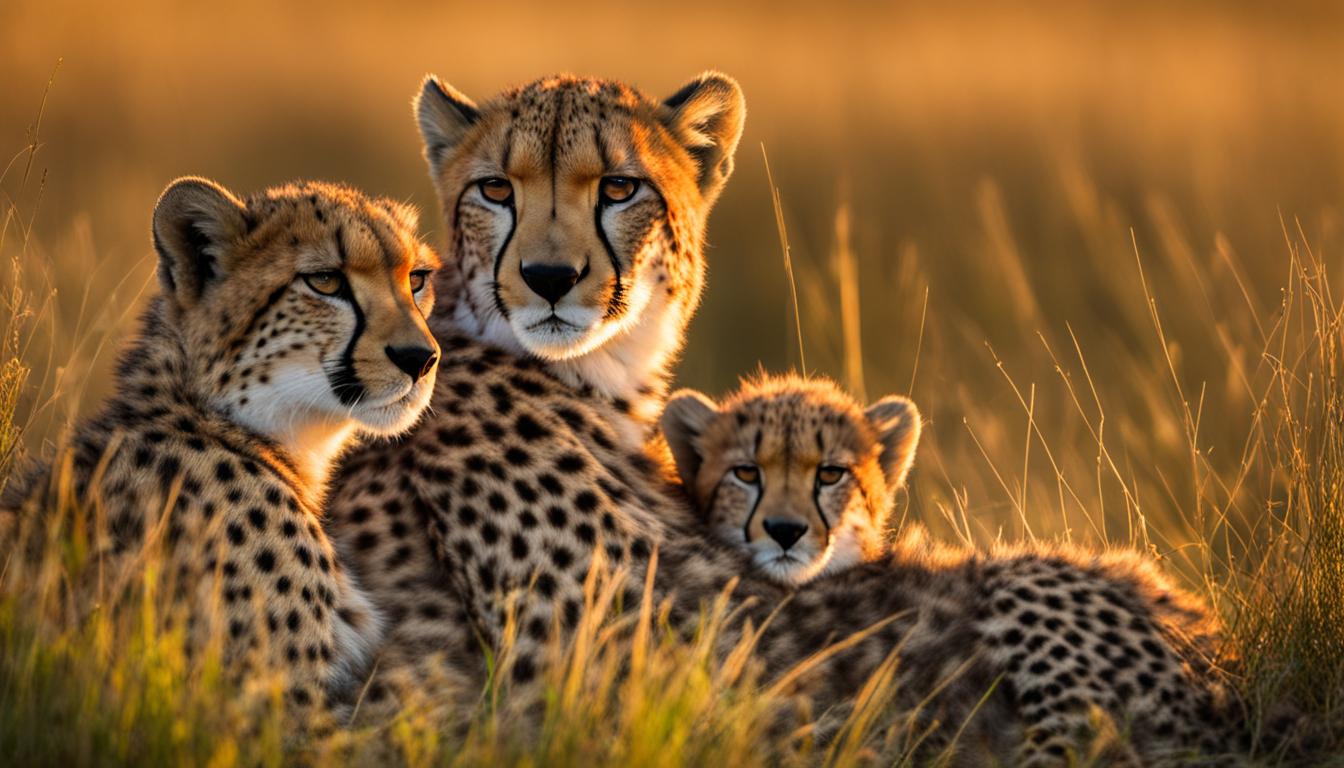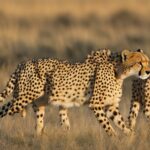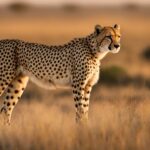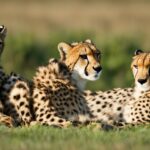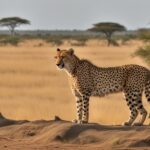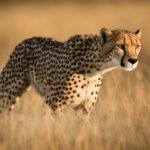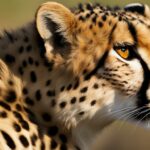In this section, we will explore the fascinating world of cheetah reproduction and the birth of their adorable cubs. Understanding the intricate details of cheetah breeding and mating behavior is essential for appreciating the wonders of nature.
Cheetahs, the fastest land animals, have a unique reproductive process. Female cheetahs give birth in intervals of 17 to 20 months, following a gestation period of 90 to 95 days. The litter sizes can vary from 1 to 8 cubs, but typically range from 3 to 5. When they are born, cheetah cubs weigh between 150 to 400 grams and open their eyes after 4 to 11 days.
Unlike male lions that may kill cubs from other males, male cheetahs show a different behavior. They don’t harm the cheetah cubs they encounter, likely due to the multiple mating partners of female cheetahs.
Stay tuned as we delve deeper into the enchanting world of cheetah cub development and maternal care in the next section.
Cheetah Cub Development and Maternal Care
During the early stages of their lives, cheetah cubs undergo remarkable development under the guidance and care of their mother. This period of growth is crucial for their survival and eventual independence. Let’s explore the various stages of cheetah cub development and the maternal care they receive.
Physical Milestones
Shortly after birth, cheetah cubs weigh between 150 to 400 grams and are adorned with a thick, grayish mane that provides them with camouflage in the wild. In just a matter of weeks, their eyes open, allowing them to observe the world around them. At around six weeks old, they begin to follow their mother, learning important skills and behaviors necessary for their future as skilled hunters.
The nursing period for cheetah cubs typically lasts between three to six months. During this time, the mother cheetah provides them with vital nutrients through her milk. As the cubs grow, they develop physical strength and coordination, enabling them to keep up with their mother during hunts and explore their surroundings.
Maternal Care and Protection
The mother cheetah plays a vital role in providing care and protection for her cubs. She will seek out new areas to rest and hide daily, ensuring the safety of her offspring. This constant vigilance helps protect the cubs from potential threats, such as predators like lions and hyenas.
The bond between the mother and her cubs remains strong throughout their time together. She teaches them essential hunting techniques and strategies, gradually allowing them to develop their own independence. Eventually, between 13 to 20 months of age, the cubs will separate from their mother and embark on their own journey through adulthood.
| Developmental Milestones | Age Range |
|---|---|
| Birth | 0 months |
| Eyes open | 4-11 days |
| Begin following mother | 6 weeks |
| Independence from mother | 13-20 months |
Understanding the development and maternal care of cheetah cubs is not only fascinating but also crucial for the conservation and preservation of this magnificent species. By studying these incredible creatures, researchers can gain insights into the factors that contribute to their survival and implement strategies to ensure their long-term well-being in the wild.
Cheetah Cubs’ Physical Characteristics and Markings
When cheetah cubs are born, they weigh a mere 8.5 to 15 ounces and are completely blind and vulnerable. However, they possess a unique physical characteristic that aids in their survival: a thick silvery-grey mantle down their back. This mantle helps camouflage the cubs by imitating the appearance of an aggressive animal called a honey badger. By resembling this fierce predator, the cubs are less likely to be targeted by other potential threats.
As the cheetah cubs grow, they undergo changes in their physical appearance. At around three months of age, they lose their mantle and their fur takes on a more uniform coloration. Their undercoat ranges in color from light tan to deep gold and is decorated with solid black spots. These spots are not only aesthetically pleasing but also play a crucial role in the cubs’ survival in their natural habitat.
The cheetah cubs also have distinctive markings known as tear stripes. These black stripes run from their eyes to their mouth and serve multiple purposes. Firstly, they protect the cubs’ eyes from the harsh glare of the sun, allowing them to maintain clear vision while hunting. Additionally, these tear stripes are believed to enhance the cubs’ cuteness and appeal, making them more likely to receive attention and care from their mother.

Cheetah Cubs’ Physical Characteristics
Table: Physical Characteristics of Cheetah Cubs
| Characteristic | Description |
|---|---|
| Weight at Birth | 8.5 to 15 ounces |
| Physical Appearance | Thick silvery-grey mantle |
| Fur Color | Light tan to deep gold |
| Markings | Solid black spots and tear stripes |
These physical characteristics and markings play integral roles in the survival and development of cheetah cubs. Their unique appearance not only helps protect them in the wild but also contributes to their continued growth and adaptation as they mature into adult cheetahs.
The Life Cycle of Cheetahs
Cheetahs go through three distinct stages in their life cycle: cub, adolescence, and adulthood. The cub stage begins at birth and lasts until the cheetah reaches around 18 months old. During this time, the cubs are heavily reliant on their mother for care and protection. Unfortunately, cub mortality is high, with less than one in 10 cubs surviving the first few months due to predation by other large predators such as lions and hyenas.
As the cheetahs enter adolescence, which typically lasts from 18 to 24 months, they start to develop their hunting skills and become more independent. They begin to separate from their mother and venture out on their own, honing their abilities to survive in the wild. This phase is crucial for their growth and adaptation to their surroundings. Adult cheetahs, categorized as those over 24 months old, have a lifespan of 10 to 12 years in the wild. Male cheetahs tend to have shorter lifespans due to territorial conflicts and competition.

Understanding the life cycle of cheetahs is essential for conservation efforts as well as for managing and preserving their genetic diversity. The high cub mortality rate underscores the challenges faced by these incredible animals in the wild. By protecting their habitats and implementing conservation measures, we can help ensure the survival and well-being of cheetah populations for future generations.
Cheetahs’ Adaptations for Speed and Hunting
Cheetahs are renowned for their incredible speed and agility, which are made possible by a range of unique adaptations. These adaptations allow cheetahs to reach astonishing running speeds, excel in hunting, and secure their survival in the wild.
One of the key adaptations is the cheetah’s body structure. Cheetahs have a flexible spine, long and slender legs, and a lightweight frame, all of which contribute to their exceptional speed. With a remarkable acceleration of over 110 kilometers per hour (70 mph) in just a few seconds, cheetahs are the fastest land animals on the planet.
Their long legs provide an extended stride length of approximately seven meters, allowing them to cover more ground with each stride. The structure of their foot pads and claws provides increased traction, enabling them to make sharp turns effortlessly while maintaining their speed. Additionally, the long tail of a cheetah acts as a rudder, helping them maintain balance and stability during high-speed chases.
Cheetahs’ hunting skills are another crucial adaptation. They possess sharp binocular vision, allowing them to accurately locate and track their prey. Their keen eyesight also helps them spot potential threats or competitors. Furthermore, cheetahs have a highly refined sense of hearing, enabling them to detect even the slightest movement in their surroundings. This acute sensory perception, combined with their incredible speed, makes cheetahs formidable hunters.
Cheetahs: Masters of Speed and Survival
Cheetahs’ adaptations for speed and hunting are a testament to the remarkable capabilities of these magnificent creatures. Their unique body structure, lightning-fast acceleration, and impressive hunting skills allow them to thrive in their natural habitat. Understanding and appreciating these adaptations is crucial not only for our knowledge of these incredible animals but also for their conservation and preservation as an endangered species.
By studying and protecting cheetah populations, we can help ensure the long-term survival of these fascinating creatures. The adaptations that make cheetahs the fastest animals on Earth are a testament to the wonders of nature and the incredible diversity of life that exists within our world.
Conclusion
Understanding the intricacies of cheetah reproduction and the raising of cubs is crucial for conservation efforts and preserving the genetic diversity of this endangered species. The process of cheetah reproduction involves specific mating behaviors and a gestation period of 90 to 95 days. Female cheetahs give birth in intervals of 17 to 20 months, with litter sizes ranging from 3 to 5 cubs.
Cheetah cubs undergo remarkable development as they grow. They are born with unique markings, including a thick silvery-grey mantle that provides camouflage. As they mature, their mantle is lost, and their undercoat develops into a light tan to deep gold color with solid black spots. Distinctive black tear stripes protect their eyes from the sun’s glare.
In addition to their physical characteristics, cheetahs have remarkable adaptations for speed and hunting. They are built for speed with a flexible spine, long legs, and a lightweight frame. Cheetahs can reach speeds greater than 110 kilometers per hour (70 mph) in just over three seconds. Their foot pads and claws provide increased traction, and their long tail acts as a rudder for balance. Exceptional hunting skills, learned early in life, play a crucial role in their survival.
As we continue to study and appreciate the reproduction, cub development, and adaptations of cheetahs, we can work towards ensuring the long-term survival of this magnificent species. By raising awareness and supporting conservation efforts, we can protect and preserve the cheetah’s place in our ecosystem.
Is the process of cheetah birth and raising cubs similar to that of leopards?
Cheetah birth and raising cubs differ from leopards interacting in the wild. Cheetahs give birth to litters of up to 6 cubs in dense vegetation, while leopards usually have 2-4 cubs in secluded dens. Cheetah mothers are solely responsible for raising their cubs, while leopards have been observed interacting with their young.
How Does the Conservation Status of Cheetahs Affect the Process of Birth and Raising Cubs?
The current cheetah conservation status has a direct impact on the process of birth and raising cubs. With dwindling numbers in the wild, cheetahs are facing increased challenges in finding suitable habitats and resources to support their offspring. This puts additional strain on the already fragile population.
FAQ
What is the process of cheetah birth and raising cubs?
Female cheetahs give birth in intervals of 17 to 20 months, with a gestation period of 90 to 95 days. Litter sizes typically range from 3 to 5 cubs. Cubs are born weighing 150 to 400 grams and open their eyes after 4 to 11 days. Male cheetahs do not kill cheetah cubs they encounter, potentially due to the multiple mating partners of female cheetahs.
What is the development and care of cheetah cubs?
Cheetah cubs are born with a thick grayish mane that provides camouflage. They begin following their mother after 6 weeks and are taught to hunt until they separate after 13 to 20 months. The nursing period ranges from 3 to 6 months. The mother cheetah will seek out new areas to rest and hide almost daily to protect her cubs.
What are the physical characteristics and markings of cheetah cubs?
Cheetah cubs weigh 8.5 to 15 ounces at birth and are blind and helpless. They have a thick silvery-grey mantle down their back, which camouflages them by imitating an aggressive animal called a honey badger. Cubs lose their mantle at about three months of age. The cheetah’s undercoat ranges in color from light tan to deep gold and is marked by solid black spots. Distinctive black tear stripes run from the eyes to the mouth, protecting their eyes from the sun’s glare.
What is the life cycle of cheetahs?
The life cycle of cheetahs consists of three stages: cub (birth to 18 months), adolescence (18 to 24 months), and adulthood (24 months and beyond). Cub mortality is high, with fewer than one in 10 cubs surviving the first few months due to predation by other large predators. Adult cheetahs in the wild have an average lifespan of 10 to 12 years, with males living shorter lives due to territorial conflicts.
What are cheetahs’ adaptations for speed and hunting?
Cheetahs are built for speed with a flexible spine, long legs, and a lightweight frame. They can reach speeds greater than 110 kilometers per hour (70 mph) in just over three seconds, with a stride length of seven meters. Their foot pads and claws provide increased traction for sharp turns, and their long tail acts as a rudder for balance. Cheetahs’ exceptional hunting skills are learned early in life and play a crucial role in their survival.

